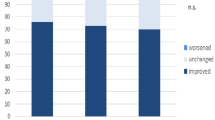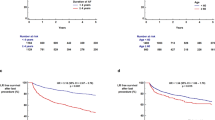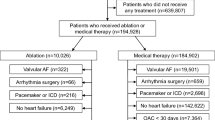Abstract
Objective
The purpose of this study was to assess the incidence, predictors, and prognostic clinical impact of atrial fibrillation (AF) over time after cavotricuspid isthmus (CTI) ablation of typical atrial flutter (AFL).
Methods
This was a follow-up observational study using 408 patients who underwent CTI AFL ablation between 1998 and 2010. The relationships between the different predictors and the outcomes (AF, stroke, and death) were modeled by means of multistate Cox model analyses.
Results
The incident rate of AF per 100 person-years during follow-up was 10.2 (95 % CI 8.7–11.8). Prior AF and chronic obstructive pulmonary disease (COPD) were the only independent variables to predict AF occurrence in the population. Their hazard ratios (HRs) were 2.55 (95 % CI 1.84–3.52) and 1.56 (95 % CI 1.08–2.27), respectively. Patients who transitioned to AF had an increased risk of death by an HR of 2.82 (95 % CI 1.88–4.70) and an increased risk of stroke by an HR of 2.93 (95 % CI 1.12–8.90). Age, COPD, and heart failure (HF) were predictive factors of death by HRs of 1.05 (95 % CI 1.00–1.08), 2.85 (95 % CI 1.39–5.83), and 2.72 (95 % CI 1.15–6.40), respectively. Age, smoking, COPD, and HF were predictive factors of death in the group of patients with AF during follow-up. HRs were 1.07 (95 % CI 1.02–1.12), 2.55 (95 % CI 1.55–4.21), 7.60 (95 % CI 3.01–19.16), and 3.07 (95 % CI 1.18–7.95), respectively.
Conclusions
The transition to AF after CTI AFL ablation was high during a long-term follow-up period and maintained over time. Prior AF and COPD were the primary predictors of transition to AF after CTI AFL ablation. Patients who transitioned to AF had an increased risk of stroke and a more than twofold mortality rate. These clinical implications make it necessary to investigate AF after CTI ablation.





Similar content being viewed by others
Abbreviations
- AFL:
-
Atrial flutter
- AF:
-
Atrial fibrillation
- CTI:
-
Cavotricuspid isthmus
References
Waldo AL, Feld GK (2008) Inter-relationships of atrial fibrillation and atrial flutter: mechanisms and clinical implications. J Am Coll Cardiol 51:779–786
Moreira W, Timmermans C, Wellens HJ et al (2007) Can common-type atrial flutter be a sign of an arrhythmogenic substrate in paroxysmal atrial fibrillation? Clinical and ablative consequences in patients with coexistent paroxysmal atrial fibrillation/atrial flutter. Circulation 116(24):2786–2792
Pérez FJ, Schubert CM, Parvez B et al (2009) Long-term outcomes after catheter ablation of cavo-tricuspid isthmus dependent atrial flutter: a meta-analysis. Circ Arrhythm Electrophysiol 2(4):393–401
Paydak H, Kall JG, Burke MC et al (1998) Atrial fibrillation after radiofrequency ablation of type I atrial flutter: time to onset, determinants and clinical course. Circulation 98:315–322
Schmieder S, Ndrepepa G, Dong J et al (2003) Acute and long-term results of radiofrequency ablation of common atrial flutter and the influence of the right atrial isthmus ablation on the occurrence of atrial fibrillation. Eur Heart J 24(10):956–962
Bertaglia E, Zoppo F, Bonso A et al (2004) Northeastern Italian study on atrial flutter ablation investigators. Long term follow up of radiofrequency catheter ablation of atrial flutter: clinical course and predictors of atrial fibrillation occurrence. Heart 90(1):59–63
Chinitz JS, Grestenfeld EP, Marchlinski FE et al (2007) Atrial fibrillation is common after ablation of isolated atrial flutter during long term follow up. Heart Rhythm 4:1029–1033
Meira-Machado L, Cadarso-Suárez C, de Uña-Álvarez J et al (2009) Multi-state models for the analysis of time to event data. Stat Methods Med Res 18:195–222
Carstensen B, Plummer M, Hills M et al (2010) Epi: a package for statistical analysis in epidemiology. R package version 1.15.2. http://CRAN.R-project.org/package=Epi
R Development Core Team (2013) R: a language and environment for statistical computing. R Foundation for Statistical Computing. http://www.R-project.org. Accessed 8th January 2013
Halligan SC, Gersh BJ, Brown RD et al (2004) The natural history of lone atrial flutter. Ann Intern Med 140:265–268
Ellis K, Wazni O, Marrouche N et al (2007) Incidence of atrial fibrillation post-cavotricuspid isthmus ablation in patients with typical atrial flutter: left-atrial size as an independent predictor of atrial fibrillation recurrence. J Cardiovasc Electrophysiol 18(8):799–802
Laurent V, Fauchier L, Pierre B et al (2009) Incidence and predictive factors of atrial fibrillation after ablation of typical atrial flutter. J Interv Card Electrophysiol 24:119–125
Healey J, Connolly S, Gold M et al (2012) Subclinical atrial fibrillation and the risk of stroke. N Engl J Med 366:120–129
Moubarak G, Pavin D, Donal E et al (2011) Ischemic strokes after ablation of typical atrial flutter. Int J Cardiol 147(1):183–184
Sode B, Dahl M, Nordestgaard B (2011) Myocardial infarction and other co-morbidites in patients with chronic obstructive pulmonary disease: a Danish nationwide study of 7.4 million individuals. Eur Heart J 32:2365–2375
Maclay J, McAllister D, McNee W (2007) Cardiovascular risk in chronic obstructive pulmonary disease. Respirology 12:634–641
Arnaudis B, Lairez O, Escamilla R et al (2013) Impact of chronic obstructive pulmonary disease severity on symptoms and prognosis in patients with systolic heart failure. Clin Res Cardiol 101:717–726
Goodman SG, Wojdyla D, Piccini J et al (2013) Factors associated with major bleeding events: insights from the rivaroxaban once-daily oral direct factor Xa inhibition compared with vitamin K antagonism for prevention of stroke and embolism trial in atrial fibrillation (rocket AF). J Am Coll Cardiol. doi:10.1016/j.jacc.2013.11.013 (pii):S0735-1097(13)06208-6, (Epub ahead of print)
Niewlaat R, Prins MH, Le Heuzey JY et al (2008) Prognosis, disease progression, and treatment of atrial fibrillation patients during 1 year: follow-up of the Euro Heart Survey on atrial fibrillation. Eur Heart J 29:1181–1189
Benjamim E, Wolf P, D’Agostin R et al (1998) Impact of atrial fibrillation on the risk of death: the Framingham heart study. Circulation 98:946–952
Krahn AD, Manfreda J, Tate RB et al (1995) The natural history of atrial fibrillation: incidence, risk factors and prognosis in the Manitoba follow-up study. Am J Med 98:476–484
Conen D, Chae C, Glynn R et al (2011) Risk of death and cardiovascular events in initially healthy women with new-onset atrial fibrillation. J Am Med Assoc 305:2080–2087
The Stroke Risk in Atrial Fibrillation Working Group (2007) Independent predictors of stroke in patients with atrial fibrillation. A systematic review. Neurology 69:546–554
Haft JI (2012) The importance of atrial fibrillation/flutter as a cause of ischemic stroke. Int J Cardiol 158:143–144
Providència R, Barra S, Paiva L (2013) Atrial fibrillation, elevated troponins, ischemic stroke, and adverse outcomes: understanding the connection. Clin Res Cardiol 102:701–711
Tomson T, Kapa S, Bala R et al (2012) Risk of stroke and atrial fibrillation after radiofrequency catheter ablation of typical atrial flutter. Heart Rhythm 9:1779–1784
Conflict of interest
On behalf of all authors, the corresponding author states that there are no conflicts of interest.
Author information
Authors and Affiliations
Corresponding author
Rights and permissions
About this article
Cite this article
Seara, J.G., Roubin, S.R., Gude Sampedro, F. et al. Risk of atrial fibrillation, stroke, and death after radiofrequency catheter ablation of typical atrial flutter. Clin Res Cardiol 103, 543–552 (2014). https://doi.org/10.1007/s00392-014-0682-6
Received:
Accepted:
Published:
Issue Date:
DOI: https://doi.org/10.1007/s00392-014-0682-6




